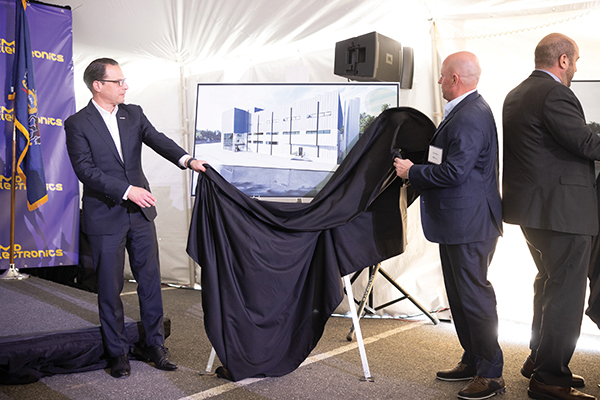
Today’s global economy doesn't wait for businesses or states to catch up. This means companies need to locate in a state that moves and innovates at the speed of business. In Pennsylvania, we are pioneering the latest technological and scientific advances in energy, biotech and robotics. We're developing collaborative support networks for early-stage entrepreneurs. And we are pursuing smart, creative approaches to workforce training and community development.
Pennsylvania is the most economically diverse state in the U.S. Its $930 billion GDP makes it the sixth-largest economy in the country and a leading global economic hub. From corporate headquarters (Pennsylvania is home to 23 Fortune 500 companies), to state-of-the-art research and development facilities to more than one million small businesses and startups, the state’s business environment empowers companies to be revolutionaries in their industries and redefine success.
Leading the Global Energy Transition

Pennsylvania has been at the forefront of every major energy transition since the industrial revolution, from coal to nuclear to natural gas. Today, Pennsylvania produces the second-largest amount of energy from all sources in the U.S. and is the second-largest producer of natural gas in the country.
Pennsylvania is poised to lead the next global energy transition because of key competitive advantages including our world-class energy assets, available and suitable sites, outstanding educational and research institutions with expertise in energy, access to domestic and international markets, and a culture of deep collaboration between the private and public sectors.
As hydrogen becomes the next frontier of sustainable and clean energy, Pennsylvania will be a national leader in developing and adopting hydrogen technologies. The state is seeing investments in the commercial-scale deployment of low-cost, clean hydrogen – a valuable energy product that can be produced with zero or near-zero carbon emissions.
This is why, in October 2023, when the U.S. Department of Energy (DOE) announced awards for seven Regional Clean Hydrogen Hubs projects, Pennsylvania was the only state in the nation to secure two regional hubs. These two regional hubs are expected to create more than 41,000 good-paying jobs and cement Pennsylvania’s standing as an energy leader for decades to come.
These two projects, called the Mid-Atlantic Hydrogen Hub (MACH2) and the Appalachian Regional CleanHydrogen Hub (ARCH2), will include hydrogen production, transportation infrastructure and end-use sites across Pennsylvania, as well as West Virginia, Ohio, Delaware and Southern New Jersey. Combined, these investments will generate clean hydrogen while mitigating harmful emissions and reusing existing energy infrastructure. These new regional hydrogen hubs will play a crucial role in addressing climate and energy security goals for Pennsylvania and the United States.
Anchored in Philadelphia, the MACH2 project extends into the surrounding region and is expected to create 20,800 direct jobs (14,400 in construction; 6,400 in permanent jobs). The DOE will provide up to $750 million in support. MACH2 will unlock hydrogen-driven decarbonization in the Mid-Atlantic while repurposing historic oil infrastructure and using existing rights-of-way. It plans to develop renewable hydrogen production facilities from renewable and nuclear electricity using both established and innovative electrolyzer technologies, helping reduce costs and drive further technology adoption.
Based in West Virginia and reaching into the Appalachian region including Southwest Pennsylvania, the ARCH2 hub is expected to create more than 21,000 direct jobs (more than 18,000 in construction and more than 3,000 permanent jobs). The DOE will provide up to $925 million in support. ARCH 2 will leverage the region’s ample access to low-cost natural gas to produce low-cost clean hydrogen and permanently and safely store the associated carbon emissions. The strategic location of this hydrogen hub and the development of hydrogen pipelines, multiple hydrogen fueling stations and permanent CO2 storage will help drive down the cost of hydrogen distribution and storage.
Building the Semiconductor Supply Chain

Photo provided by Commonwealth Media Services.
Meanwhile, as the U.S. emphasizes the reshoring of supply chains – particularly for critical industries like semiconductor manufacturing – Pennsylvania has stepped up to the plate. The Commonwealth is particularly well-equipped to handle semiconductor supply chain projects. Pennsylvania’s economy is fueled by manufacturing, accounting for nearly 10 percent of all jobs. In addition to having the workforce, sites, energy infrastructure and strategic location that semiconductor companies and all manufacturers need, Pennsylvania also benefits from more unique strategic advantages that semiconductor companies are specifically seeking.
Pennsylvania and the surrounding North Atlantic region is home to the densest concentration of clean rooms and other research infrastructure in the world. Cutting-edge facilities like the Singh Center for Nanotechnology at the University of Pennsylvania, the Claire & John Bertucci Nanotechnology Laboratory at Carnegie Mellon University, and Penn State University’s Millennium Science Complex (home to the Materials Research Institute and the Huck Institutes of the Life Sciences) are part of a rich network that offer industry access to multi-disciplinary researchers in diverse fields ranging from materials research and nanotech to life sciences, engineering and applied science.
Additionally, the Commonwealth offers a stable climate with abundant water resources. With 40+ inches of annual precipitation, 2.5 trillion gallons of surface water and 80 trillion gallons of groundwater, even the most water-demanding semiconductor and supply chain company will have its natural resource needs met.
The diversity of Pennsylvania’s economy (ranked the number one most diverse in the nation by Bloomberg) enables a vast ecosystem for the semiconductor industry. From advanced manufacturing to the research and development of new technology like advanced chip packaging, novel assemblies, power management and materials beyond silicon, Pennsylvania has the world-class facilities and talent to do it all.
This is why Pennsylvania has recently seen the expansion of companies like EMD Electronics, which produces specialty gases required in semiconductor manufacturing. The expansion in Northeast Pennsylvania – a $300 million investment that is creating nearly 200 jobs – will be the largest integrated specialty gases facility in the world. It is enabling EMD Electronics to meet surging demand in the electronics and semiconductor industries by doubling the production capacity of tungsten hexafluoride and nitrogen trifluoride, critical components in semiconductor manufacturing. In Pennsylvania’s Lehigh Valley region, the company Coherent recently announced an investment of $1 billion to increase production of silicon carbide wafers for semiconductors.
A Perfect Location
One of the biggest reasons that semiconductor and energy companies are thriving in Pennsylvania is because of its strategic location. With an optimal location in the heart of nearly 40 percent of the U.S. population and 60 percent of Canada’s population that’s close to four of the 10 largest U.S. markets and situated midway between the East Coast financial and regulatory hubs, its strategic Northeast location offers prime access for global companies to top U.S. markets. Its three major ports — Pittsburgh, Philadelphia and Erie — offer access to the Atlantic Ocean, the Great Lakes and the Gulf of Mexico.
Reaching these markets is easy and convenient because of a comprehensive transportation network that includes:
• 120,000 miles of state and local highways, including a 500+ mile state turnpike;
• 64 railroads covering 5,600 miles and hauling over 170 million tons of freight each year;
• Comprehensive intermodal infrastructure that offers unimpeded goods movement to any destination, whether via port, rail or truck; and
• Six international airports that move more than 600,000 tons of material annually.
Pennsylvania has seen explosive growth among logistics companies operating in the state over the past several years – but the transportation and energy infrastructure here in the Commonwealth is a boon to business across many industry sectors – especially manufacturing.
Learn More about Pennsylvania
With so many strategic advantages for businesses and quality of life amenities for your employees, Pennsylvania is simply a great place for companies to grow and thrive. To learn more about Pennsylvania’s business climate, communities and incentive programs, or to speak with an economic development professional, visit the PA Department of Community and Economic Development website at dced.pa.gov. T&ID

